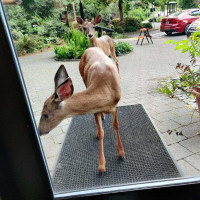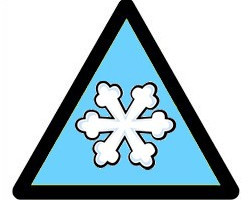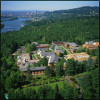Our Natural Neighbors: The Black-Tailed Deer
At the beginning of the year, I shared an article about the various wildlife we have here on campus. I’ve spoken to many of you in person who have encountered some of them yourself. As this term comes to a close, I want to take a moment to not only reflect on our impact so far, but keep an eye on returning following this short Fall break and Winter Break as well. Allow me to introduce you to one of our many neighbors, the Black-Tailed Deer.
The largest animal to share our campus is a herd of black-tail deer. From what we can tell, there are two main groups that enjoy coming onto our campuses, and a few stragglers that like to explore on their own. What is interesting, is that our officers have often spotted the same groups having a favorite location.

This trio of black-tail can often be found in the evenings grazing in the rose gardens, lower residential, or around SOA and the Chapel. In the previous article, there was a picture of them hanging out in the parking lot below Griswold. These three always seem to travel together.

The final doe that has been witnessed around campus frequents the Law campus. She is often spied in the wooded areas behind Boley Library, and has even come as high as the ledge behind the Boley windows. As she has only been seen on her own, and calls the Law Campus home, we decided it fitting to break away from the Marvel theme and felt “Elle Woods” seemed a more fitting name.
It is important to remember that these are wild animals and should remain as such. They should never be fed by human hands, or given human food, as that will decrease their natural fear of human interaction. This could cause them to enter into harmful circumstances seeking food from other humans, such as into a backyard with an aggressive dog or into vehicle traffic. We want you to admire them, but please respect their boundaries and keep your distance. Additionally, going off the established pathways and into the woods on unapproved trails, scares the animals out of their natural routine, and forces them away from campus altogether. Leaving littler behind and noxious fumes from smoking in the wooded area, also deters them from their normal grazing zones. So please consider how your actions might impact all life within our community.
Remember: Respecting the campus is respecting the natural world that surrounds it as well.
More Campus Safety Stories
Campus Safety is located in Campus Safety on the Undergraduate Campus.
MSC: 107
email safety@lclark.edu
voice 503-768-7855
fax 503-768-7195
Emergency 503-768-7777
Alternate Phone 503-593-5457
Director Jay Weitman
Campus Safety
Lewis & Clark
615 S. Palatine Hill Road MSC 107
Portland OR 97219

